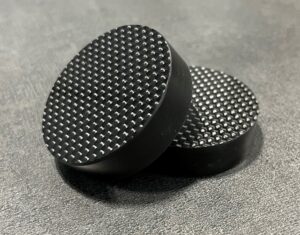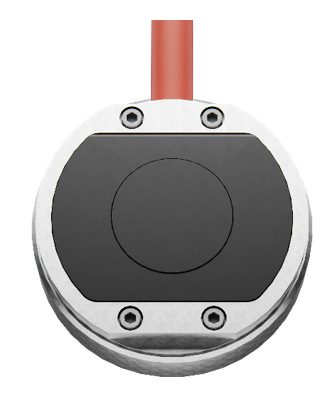Since its development over 50 years ago, carbon fiber has evolved to become one of the most used materials in automotive, aerospace, and sporting goods industries today. Carbon fiber materials are ideally suited for applications that require high strength, low weight, and high thermal resistance.
Understanding the thermal properties of a material is vital for a variety of fields and applications. Strength, weight, and durability all play important roles in the outcome for any material but the thermophysical properties are crucial characteristics to consider when designing a product. Thermophysical properties account for how much heat a product can store and even how well a product will perform over its expected lifespan. In this application, we will be investigating the directional thermal properties of carbon fiber.
A single sample of carbon fiber was measured for thermal conductivity (W/m·K) and thermal diffusivity (MJ/m3K) using the Measurement Platform Versatile (MP-V) with Modified Transient Plane Source (MTPS) sensor with Anisotropic module. The MP-V is used to measure the thermal conductivity and diffusivity of isotropic, anisotropic, and slab materials.
Carbon fiber is a lightweight organic polymer composed mostly of pure carbon atoms bonded together to form long thin chains. The thin fibers are weaved together and are typically bound with a thermoplastic or resin, resulting in a large degree of anisotropy within the carbon fiber material. This reinforcement gives carbon fiber its high strength and rigidity, making it five times stronger than steel on some occasions. The different strengths and the type of reinforcement material used also influences the thermal conductivity of carbon fiber. Highly conductive materials such as graphite and diamond cause a large increase in the thermal conductivity of carbon fiber.
Carbon fiber is known for its high stiffness, low weight, high chemical resistance, and high-temperature tolerance. These properties allow carbon fiber to be used widely across a range of industries. With all these unique properties and uses it is clear why carbon fiber has become increasingly popular in recent years.

Figure 1. Carbon Fiber sample
The MP-V is designed to test the absolute thermal conductivity, thermal diffusivity and specific heat of solids, liquids, pastes and powders. The MP-V features a powerful combination of the transient plane source (TPS, ISO 22007-2) and transient hot-wire (THW, ASTM D7896-19) methods with a variety of sensors that are compatible with it.
The MP-V features the proprietary intelligent Transient Plane Source (iTransient) function that is designed for automation of testing and analysis. iTransient requires only the sample name as user input and the appropriate sensor and test parameters for each individual sample are determined.
The MTPS sensor is comprised of a TPS sensor configured with known backing insulation, permanently housed in a rugged single-sided configuration. This unique design combines intelligent design of sensor and measurement capabilities to generate bulk and directional properties for all materials. This sensor is capable of testing isotropic, anisotropic, slab and one-dimensional samples.

Figure 3. MTPS sensor.
The anisotropic TPS modifier is used when the sample being tested has directional thermal properties. Thermal properties in the radial and axial direction are simultaneously measured and reported in the transient analysis application, along with the reported bulk measurements.
A single piece of carbon fiber was measured in the asymmetric, configuration using the absolute MTPS sensor with anisotropic module. Optimal measurement parameters were determined using the proprietary iTransient application to achieve appropriate temperature rise and accurate, repeatable results. Using the extended sensor correction, the contact resistance between sensor and sample was measured and automatically removed. This ensures the best analysis possible is used for calculation.
Table 1. Thermophysical measurements of carbon fiber
| Temperature (ᵒC) | Axial Conductivity (W/m·K) | Axial Diffusivity (mm2/s) | Radial Conductivity (W/m·K) | Radial Diffusivity (mm2/s) |
| 23.3 | 0.628 | 0.483 | 2.095 | 1.612 |
| 0.632 | 0.486 | 2.036 | 1.566 | |
| 0.632 | 0.487 | 2.000 | 1.538 | |
| 0.628 | 0.483 | 1.981 | 1.524 | |
| 0.630 | 0.485 | 1.937 | 1.490 | |
| Mean | 0.630 | 0.485 | 2.010 | 1.546 |
| Standard Deviation | 0.002 | 0.002 | 0.060 | 0.046 |
| %RSD | 0.3 | 0.3 | 3.0 | 3.0 |
Carbon Fiber, 20 sec., 0.020 W, 23.3 °C, n=5
The thermal properties of carbon fiber were successfully determined with accuracy and good repeatability, using the MP-V, equipped with the MTPS sensor. With all its unique properties, classes, and uses, it is clear why carbon fiber is rising to become one of the most widely used materials today.
Alarifi, I. M. (2019). Investigation the conductivity of carbon fiber composites focusing on measurement techniques under dynamic and static loads. Journal of Materials Research and Technology, 8(5), 4863–4893. https://doi.org/10.1016/j.jmrt.2019.08.019
Bhatt, P., & Goe, A. (2017). Carbon Fibres: Production, properties and potential use. Material Science Research India, 14(1), 52–57. https://doi.org/10.13005/msri/140109
Zhang, J., Lin, G., Vaidya, U., & Wang, H. (2023). Past, present and future prospective of global carbon fibre composite developments and applications. Composites Part B: Engineering, 250, 110463. https://doi.org/10.1016/j.compositesb.2022.110463